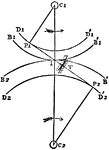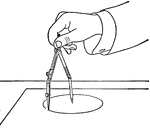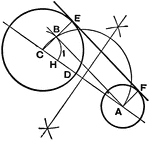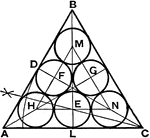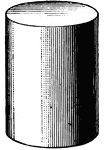
Cylinder
A cylinder is a body of uniform diameter throughout its entire length, whose ends are equal parallel…
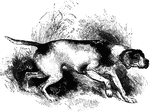
Pointer
"The pointer is the off-spring of the fox-hound and spaniel, and presents a remarkable instance of a…
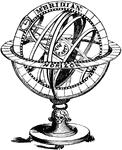
Armillary Sphere
"An arrangement of rings, all circles of a single sphere, intended to show the relative positions of…

Sea-anemone
"Their tentacles, which are disposed in regular circles, and tinged with a variety of bright lively…

Mouth of the sea-anemone
"Their tentacles, which are disposed in regular circles, and tinged with a variety of bright lively…

Scourge
"The Furies are generally represented with a scourge, with which to punish the wicked in Tartarus. It…
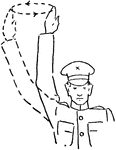
Assemble, March
"Raise the arm vertically to its full extent and describe horizontal circles." — Moss, 1914
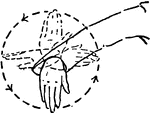
Hand signal
"Extend the arm horizontally toward the platoon leader; describe small circles with the hand." —…

Contours of a cone
The contours of a cone are circles of different sizes, one within another, and the same distance apart,…
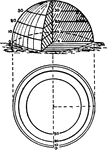
Contours of a half sphere
"The contours of a half sphere are a series of circles, far apart near the center (top) and near together…
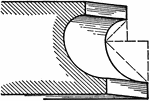
Scotia
A roman moulding, called a Scotia. It consists of two quarter circles one of which has a radius…

Cyma Recta
A roman moulding, called a Cyma Recta. It is a moulding of double curvature and two fillets.…

Cyma Reversa
A roman moulding, called a Cyma Reversa. This like the cyma recta, is composed of two quarter…

Section of Spinal Cord
"Diagram of a slice across the spinal cord, showing the roots of a spinal nerve to the arm on the left.…
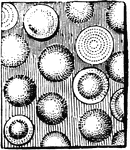
Concretionary Structure
This illustration shows a rock made up of rounded concretions, having a concentric structure.
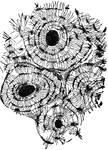
Compact Bone
"Compact bone consists of a series of concentric layers of bone disposed around a canal called the Haversian…

Compasses
"The compasses, next to the T square and triangles, are used more than any other instrument. A pencil…
Compasses
"The compasses, next to the T square and triangles, are used more than any other instrument. A pencil…

Compasses
"The compasses, next to the T square and triangles, are used more than any other instrument. A pencil…

Compasses
"The compasses, next to the T square and triangles, are used more than any other instrument. A pencil…
Compasses
"The compasses, next to the T square and triangles, are used more than any other instrument. A pencil…

Compasses
"The compasses, next to the T square and triangles, are used more than any other instrument. A pencil…
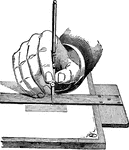
Ruling Pen
"For drawing ink lines other than arcs of circles, the ruling pen is used. It should be held as nearly…

Ruling Pen
"For drawing ink lines other than arcs of circles, the ruling pen is used. It should be held as nearly…

Irregular Curves
"Curves other than arcs of circles are drawn with the pencil or ruling pen by means of curved or irregular-shaped…
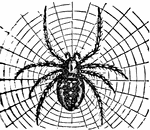
Epeira Diadema
"A genus of spiders, the type of a family called Epeirdae. They are of those spiders which have only…

Blowing-Machine
"An American machine, introduced into England by Mr. Ellis. It consists of an iron cylindrical casing…
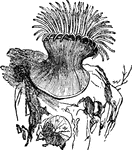
Anemone
"A popular name of the species of actinia and some other Actiniadae. It seems to have been first applied…

Anemone
"A popular name of the species of actinia and some other Actiniadae. It seems to have been first applied…
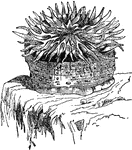
Anemone
"A popular name of the species of actinia and some other Actiniadae. It seems to have been first applied…
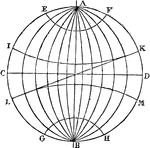
Earth Divisions
"The Earth, whose diameter is 7,912 miles, is represented by the globe, or sphere. The straight line…

Moon Phases
"Let S be the Sun, E the Earth, and A, B, C, D, F, the Moon in different parts of her orbit. Now when…
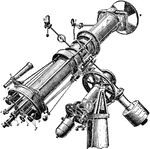
Micrometer
"The circles for position angle and declination are read by micrometer microscopes illuminated by the…
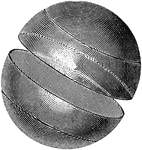
Great Circle
A Great Circle is one which would be formed on the earth's surface by a plane passing through the earth's…
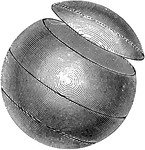
Small Circle
A small circle is one formed by a plane which does not cut the earth into two equal parts. The small…

Meridians and Parallels
The Meridian of any given place is that half of the meridian circle which passes through that place…

Structure of a Hailstone
Concentric layers, similar to those of an onion, will be noticed, arranged around a central nucleus,…

Trillium
Diagram of flower of Trillium. In this, as in all such diagrams of cross-section of blossoms, the parts…

Whirligig Beetle Larva
The whirligig beetles are a family (Gyrinidae) of water beetles that normally live on the surface of…
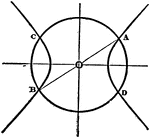
Conic Axes
Conjugate diameters perpendicular to each other are called, axes, and the points where they cut the…
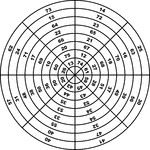
Magic Circle of Circles
The magic circle of circles, first developed by Benjamin Franklin, consists of eight annular rings and…
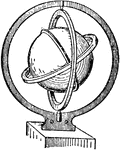
Gyroscope
Three suspended concentric circles free to move independently of each other at right angles.
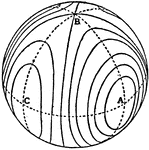
Invariable Cone
Possible forms of the invariable cone by means of the intersections with a concentric spherical surface.
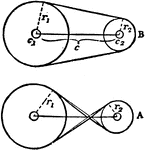
Pulley
Two arrangements of pulley: crossed belt and uncrossed belt. The pulleys are constructed with two circles…
Dividers
Hairspring dividers are for creating bisectors of circles. They are similar to a compass, but with two…
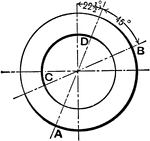
Drawing Lines 4
Circles should be unshaded or shaded evenly with thick and thin lines, changing at about 45 degrees.
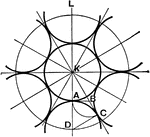
Circle to Circle Tangents
Equal circles inside and tangent to the outside circle, also tangent to each other





